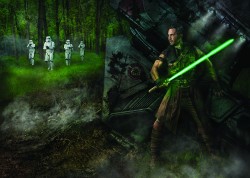Last Word | December 25th, 2015

by Chris Fradkin, PhD
It’s in the theaters. Star Wars is cleaning up and breaking all the records. Which for scientists like me shouldn’t mean a lot, I know. But inside, part of me is smiling.
It’s the Christmas lights? you say. No. The children singing carols? Uh, uh. For me, the reason runs much deeper. It’s because a study I co-authored, just released and gathering interest, is indirectly tied to Star Wars.
George Lucas, the mastermind of Star Wars, credits Joseph Campbell as the spark behind his vision. As Lucas’ mentor, Campbell, chronicler of the hero’s journey, provided focus to the up-and-coming writer. He embodied in him classic story lines.
On a much more modest scale, Campbell’s also at the center of the study that I mentioned. The study, published recently in the journal “Child Abuse & Neglect”,posits a shared history between comic superheroes and disadvantaged children. It suggests that this shared history may be used to help these children. And it’s based on Campbell’s classic hero stages.
My Brazilian research team, including Maria Angela Mattar Yunes and Gelson Weschenfelder, had heard that comic superheroes were raising patients’ spirits at the A.C. Camargo Cancer Center in Brazil. The facility had incorporated chemo-drip covers with superhero logos in the cancer center’s pediatric ward. They told the kids the drip was Superformula.
This discovery made us wonder: If pediatric cancer patients could be helped by the idea of superpowers, couldn’t other at-risk children be helped too? And couldn’t they find comfort in the knowledge that their hardships were hardships that others had gone through? And what if, we asked ourselves: What if the others that we speak of were “pre-cloak” comic superheroes?
The gears were set in motion. The first step? A compilation of the childhood adversities of the top-20 comic superheroes. In the compilation, we focused on adversities in the superheroes pre-empowered, “pre-cloak” stage: the stage preceding what Campbell terms “initiation.”
Our findings were astounding. Among the top-20 comic superheroes: 86 percent were orphaned or abandoned, 49 percent had at least one parent murdered, 29 percent were bullied and 29 percent had economic struggles. And like many at-risk children, most of the superheroes had weathered multiple adversities.
Their history, we discovered, was very closely shared with children orphaned or abandoned by their families. These children typically have higher rates of risk behavior (substance abuse, truancy, teen pregnancy) and psychosocial issues (aggression, depression, suicide) than non-affected children in the population.
This got us thinking: For these children to learn their childhood was the same as a comic superhero’s might reduce their isolation, it might build a common ground, and it might give them sense of being part of a community. For them to know the struggles they’ve endured are shared by others who survived, might bring comfort in a way they’ve never known.
And yes, this study’s the beginning: a shaft of light shone through a door. There’s so much to do to test its real potential.
But when I’m walking past the queue for the Star Wars midnight show; in the freezing cold, my spirit starts to warm. As I hear the Lucas soundtrack bleeding through the doors, it makes me smile and think of Joseph Campbell.
[Dr. Fradkin recently completed a pós-doc at Centro Universitário La Salle, in Canoas, Brazil. His research has appeared in Health Psychology, Academic Pediatrics, Asian American Journal of Psychology, Psicologia: Reflexão e Crítica, and Child Abuse & Neglect. Fradkin is lecturing in the spring at the University of California, Merced, and plans a trip back to Brazil in the summer.]
December 18th 2025
November 18th 2025
September 23rd 2025
June 19th 2025
June 19th 2025

_(1)__293px-wide.jpg)
_(1)__293px-wide.png)

_(1)_(1)_(1)__293px-wide.jpg)
_(1)_(1)_(1)__293px-wide.jpg)